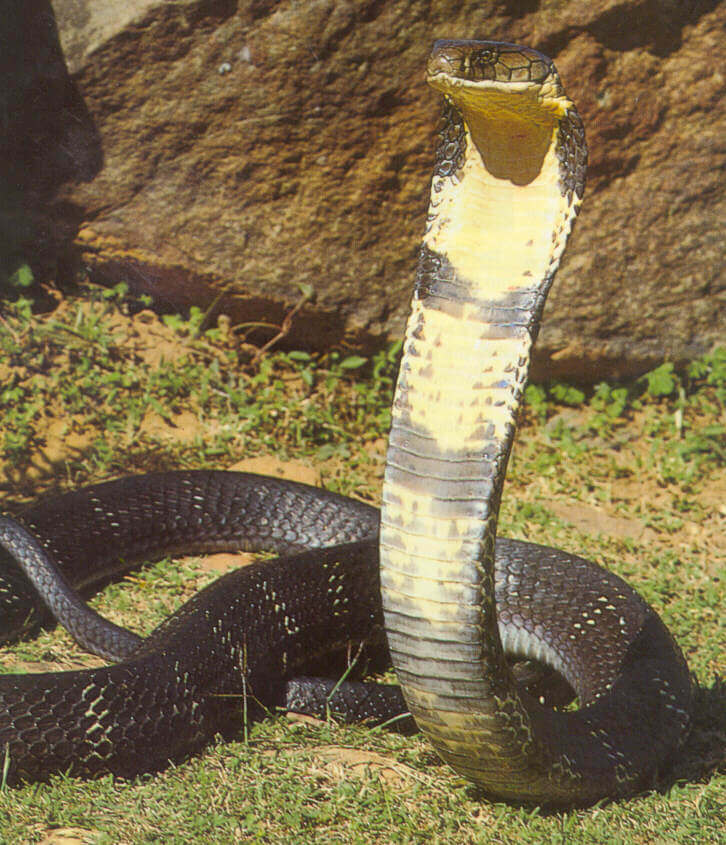Although most humans fear snakes and why don’t we, an
estimated 5.4 million people are bitten each year by them, resulting
in a lot of death.
Most of snakes are shy and don’t attack at first contact.
It’s only the feared rushing movements that snakes in their defense bite
releasing deadly poisons.
Snakes are carnivores (meat-eaters). They can't bite food so have to swallow
it whole.
Snake venom is made by organs that evolved from salivary glands. Ordinary saliva contains enzymes to help digest food as you chew it.
There are more than 3,000 species of snakes in the world and there is at least one type of snake on every continent except Antarctica.
Let’s look at some of the most feared and venomous snakes in the world.
Table of Content
Saw scaled viper
Saw-scaled viper inhabit in arid regions and dry savannas north of the
Equator across Africa, Arabia, and southwestern Asia to India and Sri Lanka.
They are characterized by a stout body with a pear-shaped head that is
distinct from the neck, vertically elliptical pupils, rough and strongly
keeled scales, and a short thin tail.
On both sides of the body are several rows of obliquely arranged serrated scales. Adults range in length from 0.3 to 0.9 meters (1 to 3 feet).
Their coloration includes various shades of brown, gray, or orange with darker dorsal blotches and lateral spots.
Saw-scaled vipers move by sidewinding locomotion.
They are nocturnal, coming out at twilight to hunt for food. It includes
mammals, birds, snakes, lizards, amphibians, and invertebrates (such as
scorpions and centipedes).
Saw-scaled vipers are small, but their irritability, aggressive nature, and
lethal venom makes them very dangerous.
When alarmed, saw-scaled vipers will move slowly with the body looped into
S-shaped folds.
The oblique scales are rubbed against each other to produce a hissing sound,
which is a defensive alarm used to warn potential predators.
These snakes are quick to strike, and mortality rates for those bitten are high. Which makes them most venomous snakes in the world.
Saw-scaled vipers are responsible for more human deaths than all other snake species combined.
King cobra
Their venom is not the most potent among venomous snakes.
But the amount of neurotoxin they can deliver in a single bite—up to two-tenths of a fluid ounce—is enough to kill 20 people or even an elephant.
Fortunately, king cobras are shy and will avoid humans whenever possible,
but they are fiercely aggressive when cornered.
King cobras live mainly in the rain forests and plains of India, southern
China, and Southeast Asia, and their coloring can vary greatly from region
to region.
They are comfortable in the trees, on land, and in water, feeding mainly on other snakes, venomous and nonvenomous, lizards, eggs, and small mammals.
They are the only venomous snakes in the world that build nests for their eggs, which they guard ferociously until the hatchlings emerge.
Tiger snake
Tiger snake, an Australian member of the cobra family.
The snake’s venom, which contains a blood-clotting agent as well as a nerve
paralyzer is potentially fatal to humans.
Before striking, the tiger snake flattens its head and neck, cobra fashion.
Tiger snakes occur in moist areas and dry, rocky habitats of southern
Australia and adjacent islands.
They are represented by a variety of distinct populations that probably
correspond to two, or perhaps more, species.
The eastern tiger snake is the most widely distributed form, occurring
from Victoria and New South Wales to portions of South and Western
Australia.
The black tiger snake is mainly limited to arid and rocky regions in South
Australia.
Tiger snakes eat frogs, birds, and mammals, and all attain adult lengths
of 1 to 1.5 meters (3 to 5 feet).
They are live-bearers.
Inland taipan
The Inland Taipan is commonly found in semi-arid regions of central east
Australia.
Inland taipans are considered the most venomous snakes in the world by many people. They are extremely venomous and a very capable striker.
Contrary to the rather aggressive nature of its relative the coastal taipan,
this serpent is usually quite a shy and reclusive snake species.
With its placid disposition it prefers to escape from trouble. But it will defend itself and strike if mishandled, provoked, or prevented from escaping.
But it first makes a warning display by raising its forebody in a tight
S-shaped curve with their head facing the threat if the warning is ignored it will strike.
This is an extremely fast and agile snake species that can strike instantly and accurately.
It can often strike multiple times in one attack and it envenoms in almost every single case.
Unlike most other snake species, the inland taipan evolved as a mammal hunter so its venom is ultimately designed to kill warm-blooded prey, just like us.
Its venom is about 50 times more toxic than the king cobra venom.
But since it lives in very remote regions, the inland taipan hardly ever comes in contact with humans. It is therefore definitely not regarded as the most deadly snake.
Even though the inland taipan has the most toxic venom in the world,
they are killed by other animals.
Like the king brown snake that is immune to most Australian snake's venom,
and the perentie, the largest Australian monitor lizard, which will attack
large venomous snakes for prey.
The inland taipan averages a length of approximately 6 ft (1.8 m), but
larger specimens can reach up to 8 ft (2,5m) in length.
The inland taipan colour is dark tan, which ranges from a rich, dark hue
to a brownish light-green.
Colour ranges depend on the season.
We think we have scared you a lot. This much of information about this horrifying yet beautiful creature is enough to pipe down in this post.
We thank the people who worked hard to present us with the knowledge. We are now able to spread among all internet users.





Post a Comment